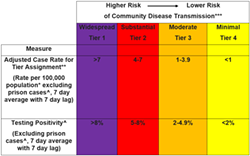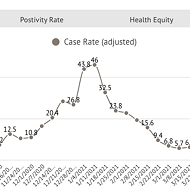Wednesday, October 7, 2020
State’s new COVID-19 health equity metric may help some counties reopen faster
Posted By Malea Martin on Wed, Oct 7, 2020 at 4:51 PM
Effective Oct. 6, the state’s Blueprint for a Safer Economy will consider an additional factor when determining a county’s reopening tier assignment: the health equity metric.
“If you look at the state, you see that there are race and ethnicity groups disproportionately affected,” Santa Barbara County Public Health Director Dr. Van Do-Reynoso said. “And we see that in our community, the Latinx population is overrepresented.”
The health equity measure, Do-Reynoso explained, ensures that tier assignments accurately reflect the spread of COVID-19 not just countywide, but also in specific neighborhoods and communities.
According to the state’s reopening website, counties with a population of more than 106,000—such as San Luis Obispo and Santa Barbara counties—must “ensure that the test positivity rates in its most disadvantaged neighborhoods, defined as being in the lowest quartile of the Healthy Places Index census tracts, do not significantly lag behind its overall county test positivity rate” when a county is entering a less restrictive tier.
Purple is the most restrictive tier, followed by red, and orange, with yellow as the least restrictive tier. Santa Barbara and San Luis Obispo counties are both in the red tier.
The California Healthy Places Index “is a composite measure of socioeconomic opportunity applied to census tracts,” according to its website. Tracts are different geographic areas defined by the census. A county’s census tracts are then divided into four quartiles based on their Healthy Places Index scores.
In order to move to a less restrictive tier, a county had to meet case rate and positivity thresholds for two consecutive weeks. Now, under the health equity metric, counties must also ensure that their lowest quartile meets the positivity threshold for the tier they’re moving into.
If a county’s positivity and case rates allow it to enter the red tier, the health equity metric must also be in the red at 8 percent or less. For those entering the orange tier, the health equity metric must be 5.2 percent or less. And finally, to enter the yellow tier, it must be 2.1 percent or less.
Gov. Gavin Newsom said at an Oct. 5 press conference that the new metric will also reward counties that do a particularly outstanding job of reducing positivity rates in socioeconomically disadvantaged areas.
For counties in purple or red tiers, such as San Luis Obispo and Santa Barbara counties, if the overall case rate “is declining but has not met threshold for the next less restrictive tier,” the Blueprint website explains that counties could still move to a less restrictive tier—if the overall positivity rate and health equity metric are two tiers better than a county’s current tier, for two consecutive weeks.
Santa Barbara County’s health equity metric, according to the state’s Oct. 5 data, is 6.7 percent, which means it’s in the red zone. This doesn’t particularly matter right now, because the county’s case rate is also red, and its overall positivity is only one higher, in the orange.
In San Luis Obispo County, the health equity metric as of Oct. 5 was at 2.4, putting it in the orange threshold. The county’s overall positivity rate is doing even better at 1.9 percent, placing the metric in the yellow, least restrictive tier. But at 5.1 percent, the case rate remains in the red tier.
Counties are assigned their tier based on their worst metric, so San Luis Obispo County remains in the red despite its positivity rate improvements. But, if SLO County could bring its health equity metric into the yellow zone for two weeks, and keep its positivity rate in the yellow zone, then it would be allowed to move to the orange tier, despite the case rate being red.
The state’s Blueprint for a Safer Economy webpage updates tier assignments weekly in the California Blueprint Data Chart. ∆
“If you look at the state, you see that there are race and ethnicity groups disproportionately affected,” Santa Barbara County Public Health Director Dr. Van Do-Reynoso said. “And we see that in our community, the Latinx population is overrepresented.”
The health equity measure, Do-Reynoso explained, ensures that tier assignments accurately reflect the spread of COVID-19 not just countywide, but also in specific neighborhoods and communities.
According to the state’s reopening website, counties with a population of more than 106,000—such as San Luis Obispo and Santa Barbara counties—must “ensure that the test positivity rates in its most disadvantaged neighborhoods, defined as being in the lowest quartile of the Healthy Places Index census tracts, do not significantly lag behind its overall county test positivity rate” when a county is entering a less restrictive tier.
Purple is the most restrictive tier, followed by red, and orange, with yellow as the least restrictive tier. Santa Barbara and San Luis Obispo counties are both in the red tier.
The California Healthy Places Index “is a composite measure of socioeconomic opportunity applied to census tracts,” according to its website. Tracts are different geographic areas defined by the census. A county’s census tracts are then divided into four quartiles based on their Healthy Places Index scores.
In order to move to a less restrictive tier, a county had to meet case rate and positivity thresholds for two consecutive weeks. Now, under the health equity metric, counties must also ensure that their lowest quartile meets the positivity threshold for the tier they’re moving into.
If a county’s positivity and case rates allow it to enter the red tier, the health equity metric must also be in the red at 8 percent or less. For those entering the orange tier, the health equity metric must be 5.2 percent or less. And finally, to enter the yellow tier, it must be 2.1 percent or less.
Gov. Gavin Newsom said at an Oct. 5 press conference that the new metric will also reward counties that do a particularly outstanding job of reducing positivity rates in socioeconomically disadvantaged areas.
For counties in purple or red tiers, such as San Luis Obispo and Santa Barbara counties, if the overall case rate “is declining but has not met threshold for the next less restrictive tier,” the Blueprint website explains that counties could still move to a less restrictive tier—if the overall positivity rate and health equity metric are two tiers better than a county’s current tier, for two consecutive weeks.
Santa Barbara County’s health equity metric, according to the state’s Oct. 5 data, is 6.7 percent, which means it’s in the red zone. This doesn’t particularly matter right now, because the county’s case rate is also red, and its overall positivity is only one higher, in the orange.
In San Luis Obispo County, the health equity metric as of Oct. 5 was at 2.4, putting it in the orange threshold. The county’s overall positivity rate is doing even better at 1.9 percent, placing the metric in the yellow, least restrictive tier. But at 5.1 percent, the case rate remains in the red tier.
Counties are assigned their tier based on their worst metric, so San Luis Obispo County remains in the red despite its positivity rate improvements. But, if SLO County could bring its health equity metric into the yellow zone for two weeks, and keep its positivity rate in the yellow zone, then it would be allowed to move to the orange tier, despite the case rate being red.
The state’s Blueprint for a Safer Economy webpage updates tier assignments weekly in the California Blueprint Data Chart. ∆
—Malea Martin







 2023 Pet Photo Contest Winners
2023 Pet Photo Contest Winners
